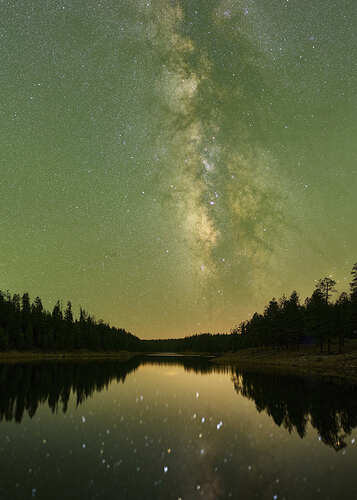Critique Style Requested: In-depth
The photographer has shared comprehensive information about their intent and creative vision for this image. Please examine the details and offer feedback on how they can most effectively realize their vision.
Self Critique
This is the first take of an idea I’ve been working on for a couple of years. I’m happy with the general composition but not so much with the technique (reflection of the MW in the lake) or final processing (the very green sky is noticeable in the RAW images with very little color correction in the final image).
I’ve been focused on improving my nightscape images for about three years now, so any feedback is appreciated, even if it’s beyond what I’m asking for here.
Creative direction
The basics for what I’m going for are here - a vertical, detailed MW reflected in the waters of the lake. For the reflection in the lake I’m not concerned about clarity of details, but the reflected light, however distorted, should mirror what the viewer sees in the sky. As for color, I try to get somewhat close to the true colors of the MW.
Specific Feedback
When it comes to shooting a reflection of the night sky in a body of water like this, what techniques are used to keep the two images temporally matched? There are two issues I’m running into: (1) the night sky is a set of tracked images and (2) the foreground is a single long exposure which ends up with the stars trailing. As a result, when I blend the sky and foreground together they are separate in time and they don’t align. I have to rotate the sky to try and match the mirror image I see in the lake. This was much harder than I expected, so I’m wondering if anyone has some tips on how to make this easier. I’m not too concerned about the star trails in the reflection, the lake isn’t still so I think it makes this less noticeable. (Out of curiosity, do the results here look “off”, or does it look like I matched it up fairly well?)
I’m puzzled by the green sky. I returned a couple of years later and got similar results, but I haven’t seen this show up in other pictures I’ve taken. Usually the color tends to be cool blues or warm yellows. I shoot with my camera white balance set to daylight exposure. If I adjust the green channel it looks better, but I then end up with a maroon cast which isn’t what I’m going for, either (and I get some weird color fringing around the trees where I blended in the two images which isn’t ideal). Some pointers or help on how to adjust the color would be appreciated.
How does the blending look at the horizon? If anyone uses Affinity Photo, I’d love to hear how you go about blending. I have a workable method, but it’s pretty tedious. (Although, to be fair, I am blending in pine trees so I’m just asking for it…)
Technical Details
Camera: Nikon Z7
Lens: Nikkor Z 20 mm f/1.8S
Sky:
- 15, 30 second exposures at f/1.8 using a tracker
- Preliminary light processing in Capture One, then tiff images are stacked in DeepSkyStacker
- Capture One used to process the final stacked image
Foreground:
- 1, 2 minute exposure at f/1.8 shot after the tracked images
- (Green color cast to the sky is visible in this image)
Final Processing
- Sky and foreground blended in Affinity Photo
Description
Located up on the Mogollon Rim, this lake is a favorite place of mine to go in the summer. One year I realized it aligns well with a vertical MW, so I’ve made two attempts now, this one and another attempt last year. (As a side bonus, you can take pictures of the ospreys fishing the lake when night gives way to morning, so I take my telephoto lens, too!)
There’s a brief window of opportunity in early summer before the summer monsoon rolls in and brings with it cloudy night skies in the high country. Late May and early June are the best times to shoot. I’ll likely try again this year unless the forests are closed due to the abysmally dry winter we’ve had. I’m really happy with the composition but I would like to get a better quality image, with the colors more closely aligned to my perception and a better reflection. When I try this again, I’ll have a wider lens (Sigma 14mm f/1.4).
Critique Template
Use of the template is optional, but it can help spark ideas.
- Vision and Purpose:
- Conceptual:
- Emotional Impact and Mood:
- Composition:
- Balance and Visual Weight:
- Depth and Dimension:
- Color:
- Lighting:
- Processing:
- Technical:
